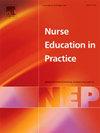护理本科预科教育中临床推理评估方法的范围综述
IF 3.3
3区 医学
Q1 NURSING
引用次数: 0
摘要
目的探讨临床推理评估方法在护理本科学历教育中的应用特点。发展临床推理是护理教育的核心期望,但由于其认知的复杂性而面临重大挑战。有效的评估方法对于支持学生的发展和理解这一过程至关重要。在资源有限的情况下,获得先进技术的机会有限,确定适应性强的方法至关重要。然而,这一领域的评价方法仍未得到充分探索。DesignScoping审查。方法采用Joanna Briggs研究所的方法和PRISMA-ScR指南,在EBSCO Host (CINAHL, MEDLINE)、ScienceDirect、Web of Science、Epistemonikos和ProQuest的论文和论文中进行全面检索。本综述纳入了关于护理学预科学生临床推理评估方法的初步研究报告,重点关注定量或混合方法研究的可测量结果。使用结构化指南提取数据,并使用描述性定性技术进行分析。结果:本综述纳入283项研究,采用不同环境下的六种主要反应形式。在样本量、结构定义、刺激形式、评分方法、答案关键发展和评分特征方面发现了相当大的差异。这些发现说明了临床推理评估的复杂性,并强调了标准化以增强一致性和可比性的必要性。本文综述了临床推理评估方法的多样性,并确定了进一步研究的重点领域。它为评估这些策略的有效性,有效性和可行性提供了基础,以支持循证,适应环境的护理教育实践。本文章由计算机程序翻译,如有差异,请以英文原文为准。
Clinical reasoning assessment methods in prelicensure undergraduate nursing education: A scoping review
Aim
To identify and characterise clinical reasoning assessment methods in prelicensure undergraduate nursing education, highlighting their key features and applications.
Background
Developing clinical reasoning is a core expectation in nursing education but poses significant challenges due to its cognitive complexity. Effective assessment approaches are critical for supporting student development and understanding this process. In resource-limited settings, where access to advanced technologies is limited, identifying adaptable methods is essential. However, assessment methods in this area remain underexplored.
Design
Scoping review.
Methods
Following Joanna Briggs Institute methodology and PRISMA-ScR guidelines, a comprehensive search was conducted in EBSCO Host (CINAHL, MEDLINE), ScienceDirect, Web of Science, Epistemonikos and ProQuest Dissertations and Theses. The review included primary studies reported on clinical reasoning assessment methods for prelicensure nursing students, focusing on measurable outcomes in quantitative or mixed-method studies. Data were extracted using a structured guide and analysed using descriptive qualitative techniques.
Results
This review included 283 studies employing six primary response formats across diverse settings. Considerable variation was found in sample sizes, construct definitions, stimulus formats, scoring approaches, answer key development and rater characteristics. These findings illustrate the complexity of clinical reasoning assessment and underscore the need for standardisation to enhance consistency and comparability.
Conclusion
This review maps the diversity of clinical reasoning assessment methods and identifies key areas for further research. It provides a foundation for evaluating the effectiveness, validity and feasibility of these strategies to support evidence-based, contextually adaptable practices in nursing education.
求助全文
通过发布文献求助,成功后即可免费获取论文全文。
去求助
来源期刊

Nurse Education in Practice
NURSING-
CiteScore
5.40
自引率
9.40%
发文量
180
审稿时长
51 days
期刊介绍:
Nurse Education in Practice enables lecturers and practitioners to both share and disseminate evidence that demonstrates the actual practice of education as it is experienced in the realities of their respective work environments. It is supportive of new authors and will be at the forefront in publishing individual and collaborative papers that demonstrate the link between education and practice.
 求助内容:
求助内容: 应助结果提醒方式:
应助结果提醒方式:


